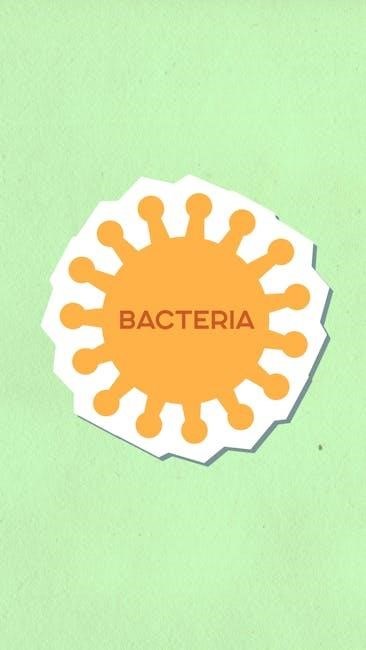Cell graphic organizers are visual tools that help students structure and organize information about cell structures and functions. They provide a clear framework for understanding complex biological concepts.
1.1 Importance of Graphic Organizers in Biology Education
Graphic organizers are essential tools in biology education‚ enabling students to visually structure and connect complex concepts. They enhance understanding of cell structures and functions‚ making abstract ideas more tangible. These organizers facilitate visual learning‚ helping students compare cell types and retain information effectively. By providing a clear framework‚ they support vocabulary development and promote deeper comprehension of biological processes‚ making them invaluable for engaging and effective science education.
1.2 Overview of the Cell Graphic Organizer Answer Key PDF
The Cell Graphic Organizer Answer Key PDF is a valuable resource designed to complement biology education. It provides detailed diagrams‚ labeled cell structures‚ and sample answers‚ aiding students in organizing and understanding complex biological concepts. The PDF includes word banks for vocabulary support‚ facilitating the learning of terms like osmosis‚ mitochondria‚ and lysosomes. It also offers comparisons between prokaryotic and eukaryotic cells‚ enabling students to visualize and retain key information effectively.

Key Components of a Cell Graphic Organizer
Cell graphic organizers include the cell membrane‚ organelles‚ and comparisons between prokaryotic and eukaryotic cells. These components help students visualize and understand cell structure and function effectively.
2.1 Cell Membrane and Its Functions
The cell membrane‚ also known as the plasma membrane‚ is a semi-permeable barrier that surrounds the cell and regulates the movement of materials in and out. It plays a crucial role in maintaining cellular integrity and facilitating communication between the cell and its environment. The cell membrane is composed of a phospholipid bilayer with embedded proteins‚ enabling functions like osmosis‚ diffusion‚ and active transport. Understanding its structure and functions is essential for comprehending cellular processes and is often highlighted in cell graphic organizers for clarity and visualization.
2;2 Organelles and Their Roles
Organelles are specialized structures within cells that perform specific functions essential for cellular survival and operation. The nucleus acts as the control center‚ housing DNA. Mitochondria generate energy through ATP production. Ribosomes synthesize proteins‚ while the endoplasmic reticulum modifies and transports them. Lysosomes contain digestive enzymes for breaking down waste. The Golgi apparatus processes and distributes cellular products. Each organelle works cooperatively to maintain cellular homeostasis and ensure proper functioning‚ making them vital components highlighted in cell graphic organizers for educational clarity.
2.3 Differences Between Prokaryotic and Eukaryotic Cells
Prokaryotic cells lack a nucleus and membrane-bound organelles‚ whereas eukaryotic cells have a nucleus and specialized organelles like mitochondria and the Golgi apparatus. Prokaryotes are generally smaller and less complex‚ with a cell wall for support‚ while eukaryotes exhibit greater diversity in size and function. These differences significantly impact how each type of cell operates‚ with eukaryotic cells capable of more complex processes. This comparison is often highlighted in cell graphic organizers to clarify fundamental biological distinctions‚ aiding students in understanding cellular evolution and functionality.
Benefits of Using a Cell Graphic Organizer
Cell graphic organizers enhance visual learning‚ improve retention‚ and simplify complex concepts. They help students organize information effectively‚ making cellular biology more accessible and engaging for understanding.
3.1 Enhancing Visual Learning and Retention
Visual learning tools‚ such as cell graphic organizers‚ significantly enhance retention by allowing students to see relationships between cell components. The structured format helps learners connect new information to prior knowledge‚ making complex biological concepts more manageable. By organizing information visually‚ students can better recall details about cell structures and functions‚ leading to improved academic performance in biology; These organizers are particularly effective for visual learners‚ providing a clear and engaging way to study.
3.2 Facilitating Comparison and Contrast of Cell Types
Cell graphic organizers enable students to effectively compare and contrast different cell types‚ such as prokaryotic and eukaryotic cells. By visually arranging information‚ these tools highlight key differences‚ like the presence of a nucleus or organelles. This structured approach helps learners identify similarities and distinctions‚ enhancing their understanding of cellular biology. The organizers often include sections for labeling and describing unique features‚ making it easier for students to grasp these concepts and apply them in their studies.
3.4 Developing Critical Thinking Skills in Students
Cell graphic organizers foster critical thinking by encouraging students to analyze and evaluate information. They require learners to categorize‚ compare‚ and connect concepts‚ promoting deeper understanding. By arranging information visually‚ students develop problem-solving skills and learn to synthesize knowledge. These tools also prompt learners to question and reflect on the material‚ enhancing their ability to think analytically and make logical connections. This active engagement with content prepares students for more advanced biological studies and real-world applications.

How to Effectively Use the Answer Key
The answer key aligns with curriculum standards‚ providing step-by-step guidance and sample answers for self-assessment. It ensures accurate completion of the cell graphic organizer.
4.1 Step-by-Step Guide to Completing the Organizer
Start by identifying cell structures using the provided word bank. Label each part accurately and describe its function. Compare and contrast prokaryotic and eukaryotic cells‚ highlighting key differences. Ensure all sections align with the answer key for accuracy. Use diagrams and sample answers as references to verify your work. This methodical approach ensures comprehensive understanding and proper completion of the graphic organizer.
4.2 Aligning the Organizer with Curriculum Standards
Ensure the graphic organizer aligns with curriculum standards by verifying it covers required topics like cell structure and function. Use the answer key to confirm accuracy and relevance. The organizer should reflect educational guidelines‚ providing a structured approach to learning. This alignment helps educators deliver content effectively and prepares students for assessments. By integrating curriculum standards‚ the organizer becomes a valuable tool for achieving learning objectives.
4.3 Utilizing the Answer Key for Self-Assessment
The answer key enables students to evaluate their work independently‚ fostering a deeper understanding of cell biology concepts. By comparing their responses with the provided answers‚ learners can identify gaps in knowledge and correct misunderstandings. This self-assessment process promotes critical thinking and reinforces learning. It also allows educators to track progress and provide targeted support‚ making the organizer a valuable resource for both teaching and learning.
Common Features of Cell Graphic Organizer Answer Keys
Common features include detailed diagrams‚ labeled cell structures‚ word banks‚ and sample answers. These elements provide clarity and support for understanding complex biological concepts effectively.
5;1 Word Banks and Vocabulary Support
Word banks in cell graphic organizers provide essential vocabulary‚ such as osmosis‚ mitochondria‚ ribosomes‚ DNA‚ ATP‚ lysosomes‚ endoplasmic reticulum‚ vesicles‚ diffusion‚ nucleolus‚ and insulin. These terms are crucial for understanding cell functions and structures. Vocabulary support helps students connect key concepts‚ aiding in the construction of clear‚ accurate answers. This feature is particularly beneficial for visual learners‚ enabling them to organize and retain information effectively‚ while reinforcing their grasp of fundamental biological terminology.
5.2 Detailed Diagrams and Labels
Cell graphic organizers often include detailed diagrams of cell structures‚ such as the cell membrane‚ mitochondria‚ lysosomes‚ endoplasmic reticulum‚ ribosomes‚ and nucleus. These diagrams are labeled to highlight specific components and their functions. Visual representations help students understand complex structures and their relationships. Labels provide clarity‚ ensuring students can identify and describe each part accurately. This feature is particularly useful for visual learners‚ as it enhances comprehension and retention of cell biology concepts. Diagrams also serve as a reference for completing the organizer effectively.
5.3 Sample Answers for Reference
Sample answers in the cell graphic organizer answer key PDF provide students with clear‚ correct responses to each section. These examples guide learners in understanding how to structure their own answers. By reviewing sample answers‚ students can grasp the expected format and depth of information. This feature is particularly helpful for self-assessment‚ allowing students to compare their work with the provided answers. It also assists educators in evaluating student understanding and ensuring accuracy in complex biological concepts. Sample answers enhance both teaching and learning effectiveness.

Where to Find Reliable Cell Graphic Organizer PDFs
Reliable cell graphic organizer PDFs can be found on educational websites‚ textbook supplements‚ and university resources. They often include answer keys for student and teacher use.
6.1 Free Educational Resources and Websites
Free educational resources and websites offer a variety of cell graphic organizer PDFs. Websites like biologycorner.com and educational platforms provide downloadable templates‚ often with answer keys. These resources are designed to support biology education‚ offering detailed diagrams‚ word banks‚ and sample answers. Teachers and students can access these tools without cost‚ making them ideal for classroom use or self-study. They are regularly updated to align with curriculum standards and provide comprehensive learning support.
6.2 Textbook Supplements and Study Guides
Textbook supplements and study guides often include cell graphic organizer answer keys as additional learning tools. Resources like SpringBoard Algebra 2 by The College Board and other educational materials provide these organizers to complement textbook content. They typically feature detailed diagrams‚ word banks‚ and sample answers‚ aligning with curriculum standards. These supplements are invaluable for students and educators‚ offering structured support for understanding cell biology concepts effectively.
6.3 University and College Course Materials
Universities and colleges often integrate cell graphic organizer answer keys into their course materials‚ particularly in biology and life sciences programs. Institutions like Far Eastern University incorporate these tools into their curriculum‚ providing students with structured resources for complex topics. These PDFs are often comprehensive‚ featuring detailed diagrams‚ word banks‚ and sample answers tailored to advanced learning. They serve as valuable supplements for lectures‚ labs‚ and independent study‚ aligning with academic standards and fostering deeper understanding.

Best Practices for Creating a Cell Graphic Organizer
To create an effective cell graphic organizer‚ use clear language‚ organize information logically‚ incorporate visuals for better understanding‚ and ensure adaptability for different learning levels.
7.1 Designing Engaging and Interactive Layouts
Designing an engaging cell graphic organizer involves using visually appealing layouts with color-coded sections‚ high-quality images‚ and interactive elements. Incorporate drag-and-drop features or clickable icons for digital versions to enhance student engagement. Use clear headings and concise labels to ensure readability. Align the design with curriculum standards while catering to diverse learning styles. Including word banks and sample answers can further enhance usability. Make it adaptable for different grade levels and learning needs to maximize effectiveness.
7.2 Incorporating Multimedia and Digital Tools
Incorporating multimedia and digital tools into cell graphic organizers enhances learning by making it interactive and dynamic. Use videos‚ animations‚ and simulations to illustrate cell processes like mitosis or photosynthesis. Embed hyperlinks to additional resources or quizzes for deeper engagement. Digital tools like mind mapping software or educational apps can help students create and customize their organizers. Audio explanations and interactive diagrams further support visual and auditory learners‚ making the tool more accessible and effective for diverse learning needs.
7.3 Tailoring the Organizer for Different Learning Levels
Tailoring cell graphic organizers for different learning levels ensures accessibility and effectiveness. For basic levels‚ simplify structures and focus on key concepts. Use word banks and diagrams for ESL or visual learners. Include extension activities for advanced students‚ such as comparing prokaryotic and eukaryotic cells. Offer optional multimedia links for deeper exploration. This customization supports diverse learning needs‚ making the organizer adaptable for various educational settings and student capabilities‚ fostering inclusivity and engagement in cell biology studies.
8.1 Summarizing the Value of Cell Graphic Organizers
Cell graphic organizers are essential tools for biology education‚ offering structured frameworks to visualize and organize cellular information. They enhance visual learning‚ improve retention‚ and simplify complex concepts. By facilitating comparisons between cell types and providing clear diagrams‚ these organizers cater to diverse learning styles. Their inclusion of word banks and sample answers supports vocabulary development and self-assessment. Ultimately‚ they empower students to construct knowledge effectively‚ fostering a deeper understanding of cell biology and its fundamental principles.
8.2 Encouraging Further Exploration of Cell Biology
Cell graphic organizers inspire students to delve deeper into cell biology by providing interactive and engaging tools. Their structured layouts and visual elements spark curiosity‚ encouraging learners to explore beyond the basics. With features like detailed diagrams and word banks‚ these organizers enable students to connect concepts‚ fostering a deeper appreciation for cellular processes. By aligning with curriculum standards‚ they offer a solid foundation for further inquiry‚ motivating students to investigate advanced topics in cell biology independently.
